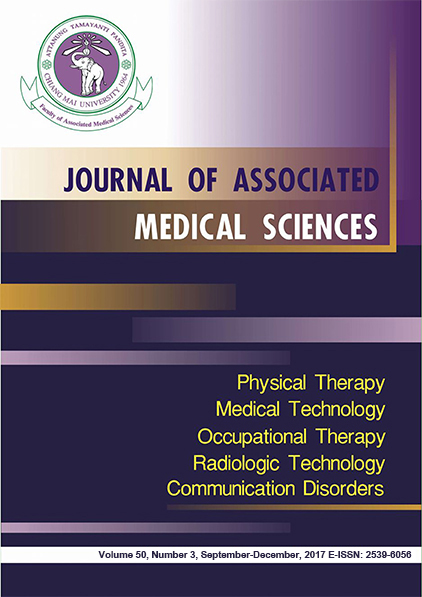Cross cultural validity and reliability of the Kid Play Profile assessment for children aged 6-9 years: Thai version
Main Article Content
Abstract
Background: Much of the work developing and testing instruments for assessing play in pediatric occupational therapy practice has occurred in English-speaking countries. Therefore, Thai occupational therapy practitioners who want to use these instruments must first carry out the work of translating them into Thai language and then validating their use in the Thai context.
Objectives: To cross-culturally adapt the Kid Play Profile from English to Thai, and to test the reliability and validity of the Thai version which was designed for children aged 6-9 years old.
Materials and methods: First stage was aimed at achieving the cross-culturally adaptation of the Kid Play Profile by using the following methods: forward translation, synthesis of the translations, back translation, expert panel committee, and test of pre-final version in 28 respondents. Second stage was to examine the internal consistency and test-retest reliability of Kid Play Profile, Thai version, in 108 respondents. Study respondents were elementary school students, grade 1-3 recruited from Wat Weruwan School, Saraphi District, Chiang Mai Province.
Results: The expert panel committee reviewed and accepted all translations. However, some activity titles were changed and some activity categories were re-grouped to attain cultural equivalence and be appropriate to use in Thai context. As a result, summer activities and winter activities were merged and renamed as seasonal activities category. All play and leisure activity items and the amount of response questions were remained as the original version. A total of twenty eight elementary school children were then tested by completing the pre-final version of the Kid Play Profile, Thai version. They were also asked to probe about their thoughts on each test item, test format, and the chosen response. Subsequently, students were clearly understood the contents of the profile. Moreover, test features with pictures representing activities and responses made the profile easy to understand and answer. No items were found missing and changing the language used in two test items were made. One hundred and eight students participated in the test-retest reliability and internal consistency reliability studies. High reliability (ICC=0.76) for the first question (Do you do this activity?) and acceptable reliability (ICC=0.74) for the second question (Do you like this activity?) were found while moderate but still acceptable (ICC=0.52) for the third question (Who do you do this activity with?). Acceptable level of internal consistency (Cronbach’s alpha) reliability was found in the first question (α=0.72), and low internal consistency was found in the second question (α=0.35).
Conclusion: This study has yielded evidence supporting the validity and reliability of the Kid Play Profile, Thai version, although caution is recommended in the administration and interpretation of the second question.
Article Details
Personal views expressed by the contributors in their articles are not necessarily those of the Journal of Associated Medical Sciences, Faculty of Associated Medical Sciences, Chiang Mai University.
References
2. Henry AD. Pediatric Interest Profiles: Surveys of Play for Children and Adolescents, Kid Play Profile, Preteen Play Profile, Adolescent Leisure Interest Profile. Therapy Skill Builders; 2000.
3. Munkhetvit P. Measuring Outcomes in Occupational Therapy. The Conference of the Faculty of Associated Medical Sciences 2009 on the occasion of the 45th Anniversary of Chiang Mai University and the 30th Anniversary of Occupational Therapy Faculty of Associated Medical Sciences Chiang Mai University; 2009 Dec 1-4; Holiday Inn Hotel Chiang Mai. Chiang Mai: The University; 2009. p. 2-57. (in Thai)
4. Praditsuktawon P. Development of Early Childhood. 2013. [online]. Available from: https://taamkru.com [2015 Nov 17]. (in Thai)
5. Beaton DE, Bombardier C, Guillemin F, Ferraz MB. Guidelines for the process of cross-cultural adaptation of self-report measures. SPINE; 2000. p. 3186-91.
6. Cha ES, Kim KH, Erlen JA. Translation of scales in cross-cultural research: Issues and techniques. J Adv Nurs 2007; 58(4): 386-95.
7. Garrett H. Testing for teachers. 2nd ed. American Book; 1965.
8. Srisathitnarakurn B. Development and Examination of Quality Research Tools: Measurement Properties Psychological. Bangkok: Chulalongkorn University Printing House; 2012. (in Thai)
9. Kielhofner G. Conceptual Foundations of Occupational Therapy Practice. 4th ed. Philadelphia: F.A. David; 2009.
10. Colon W. Validity of the newly translated and culturally-adapted Spanish version of the children’s assessment of participation and enjoyment & preferences for activities of children [Ph.D. thesis]. Florida: Nova Southeastern University; 2007.
11. King G, Law M, King S, Hurley P, Rosenbaum P, Hanna S et al. Children’s Assessment of Participation and Enjoyment and Preferences for Activities of Children. San Antonio, TX: Psychological Corporation; 2004.

